The Federation Heritage of Parkville, north of Melbourne's CBD, Victoria
[Previous post: Heritage Threats ... Next post: ]
Table of Contents
- See also Picturesque Queen Anne
- See also Federation Queen Anne Style
Federation Heritage villas, Cade Way opposite Willam St
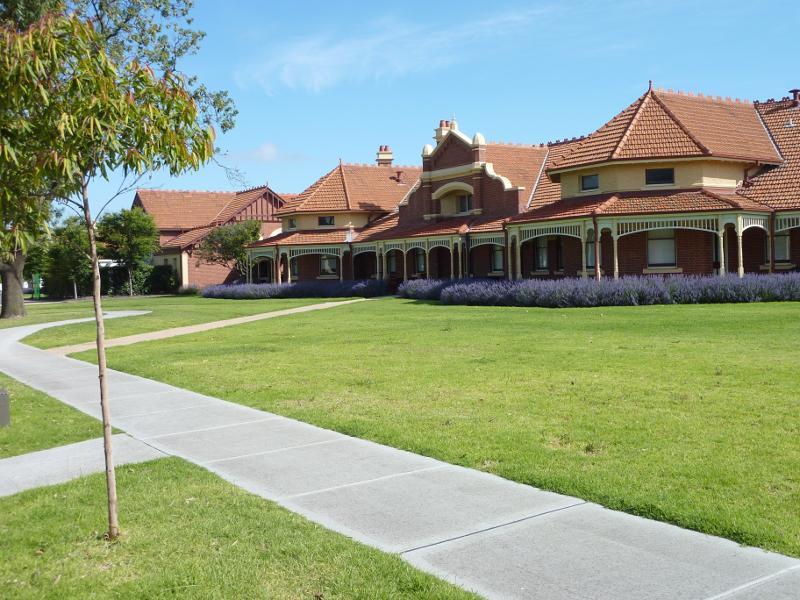 |
| Federation Heritage villas, Cade Way opposite Willam St, the Former Royal Park Psychiatric Hospital (Hospital for the Insane |
The Former Royal Park Psychiatric Hospital (Hospital for the Insane) was constructed initially between 1906 and 1913 in the pavilion form of hospital design. The architect SE Bindley of the Victorian Public Works Department used the Federation Domestic Queen Anne style. The surviving buildings include the Male and Female Acute Wards (1907-09), Male and Female Convalescent Wards (1907-09), Dining Room/Recreation Hall and Kitchen (1907-09), Female Attendants' Block.
Federation heritage properties listed in this area:
Auld Reekie, Garden and Front Fence 511 Royal PdeThe house known at Auld Reekie at 511 Royal Parade in Parkville dates from 1910, but incorporates an earlier six roomed villa named May Day which had been built in 1872 by a butcher called Henry Harper.Auld Reekie was constructed by Alexander and Jessie Sturrock who purchased the site in 1908.
| Parkville, VIC, Australia | 
| ||
House 159 Park DrAn intact double storey corner polychrome brick house with an intact interior and the unusual entry which is lower than pavement level.This corner two storey polychrome brick house, constructed in 1887 for Charles Coulson, is externally intact and has many notable features.
| Parkville, VIC, Australia |
| ||
Monaro 70 Flemington RdMonaro, built in c1910-15, is a small, intact residence displaying an unusual combination of Federation, Queen Anne and Arts and Crafts stylistic elements with Art Nouveau details.
| Parkville, VIC, Australia |
| ||
Nocklofty 551 Royal Pde**Sold $3,700,000** in Aug 2013Nocklofty is the most original and distinctive Federation style villa in Melbourne, largely because of the exemplary external wood carving and interior furniture and joinery designed and created by Munro, a champion wood carver.
| Parkville, VIC, Australia | 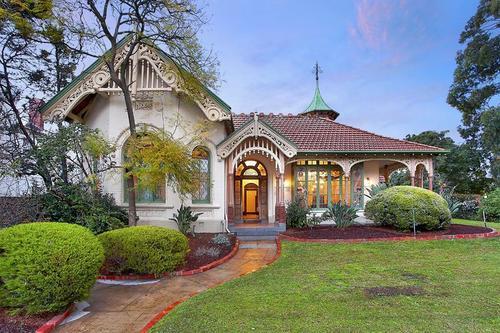 | ||
Park Keepers Lodge The AvenueThe Park Keeper's Lodge, Parkville, is a striking,polychromatic brick residence with architectural details of the Federation Free Style.
| Parkville, VIC, Australia |
| ||
Parkville Post Office 29-31 Bayles StThe Parkville Post Office and Quarters was designed in the neo-Gothic style by Public Works Department architects SE Brindley and SC Brittingham. The builder was JG McLean and the building was completed in 1889.The Parkville Post Office is of significance because it represents an early official adoption of the Gothic polychrome brickwork style.
| Parkville, VIC, Australia |
|
Photos of Parkville Residential Heritage areas[2]
Click thumbnail to view larger image:
 |  |
| Auld Reekie, 511 Royal Parade Parkville | Nocklofty, 551 Royal Pde, Parkville |
 |  |
| 262 The Avenue PARKVILLE | 25 Manningham Street, Parkville |
Parkville

- Before the 1870s much of the area was known as either Hotham (North Melbourne) or Carlton and during this time Parkville was simply a locality of Carlton. The name Park Ville came into common use after 1875 and was gradually shortened to its current form.
- Parkville is known for its leafy streets, beautiful heritage houses, the University of Melbourne’s bustling campus, and its residential colleges for students. It is also home to major hospital, research and institutional facilities including the Royal Melbourne Hospital and Royal Children’s Hospital.
- Parkville contains only small pockets of residential areas. The precinct along the western side of Royal Parade is the oldest part of Parkville and includes terrace homes and apartment blocks. In Parkville's north-western corner, off Oak Street, is Parkville Gardens. This modern housing and social development is situated on a former psychiatric hospital site that later became the athlete's village for the 2006 Commonwealth Games.
- The remainder of Parkville is taken up by huge expanses of parkland, sporting facilities, several hospitals and a number of educational institutions.
The City of Melbourne’s largest area of open space, Royal Park, can be found here, along with one of Melbourne’s major attractions, the Melbourne Zoo.
- The first institution of significance erected in the Parkville area was the University of Melbourne in 1853.
- A housing estate commenced sales in 1861 at what is now Parkville South.
- In 1868 further excisions from Royal Park were made for housing estates at Parkville North along Royal Parade and Parkville West near Flemington Road.
- By the 1870s and 1880s, Parkville was a popular area for the middle class booming with affluent terrace housing becoming the norm.[3]
 |
| Aerial of Parkville looking north. Visible is Royal Park (top left); Royal Melbourne Hospital (centre left); Royal Parade (centre) and University of Melbourne campus (right). |
Parkville is a major education, research and healthcare precinct and home to the University of Melbourne, Monash University Pharmacy faculty, Royal Melbourne Hospital, Royal Women's Hospital, Royal Children's Hospital andCSL.
- A major feature is the neighbouring Royal Park, Melbourne, an expansive parkland which is notable as home to the Royal Melbourne Zoological Gardensand was the athlete's village for the 2006 Commonwealth Games.
- Parkville was the site of the 2006 Melbourne Commonwealth Games Village, where athletes and officials were housed during the event. The site, now called Parkville Gardens, is being transformed into an integrated, socially inclusive community with private and social housing. It is designed to be part of a legacy of lasting social benefits left by the Games.The residential areas have a high median house price due to the proximity to the city and parkland, Victorian era buildings, terrace houses and tree lined streets.
- Major Projects Victoria is managing the $35.1 million post-Commonwealth Games phase of the project,
transforming the former Athletes' Village into an integrated, socially inclusive community that is a legacy of lasting social benefits left by the Games.Parkville white building - The project* has also allowed the Victorian Government to put into practice its policies on environmentally sustainable design, social housing, disabled access and community services.
- Key features of the 20-hectare development include:
- the capacity for approximately 1,000 dwellings of which 20 per cent will be dedicated to social housing
- the retention and refurbishment of 11 heritage buildings
- the creation of wetlands and new parklands
- wheelchair accessible toilets and showers in most dwellings.[4]
- Major Projects Victoria is managing the $35.1 million post-Commonwealth Games phase of the project,
- The main arterial road is Elizabeth Street, which becomes Royal Parade before becoming Sydney Road and the Hume Highway, the main highway heading towardsSydney.
- Royal Park railway station is the main railway station in Parkville, located in Royal Park to the north adjacent the zoo and is on the Upfield railway line, serviced by Metro Trains Melbourne. The planned Melbourne Metro rail tunnel with have an undergroundParkville railway station.

262 The Avenue Parkville:
Sarina Lewis, 02/05/2014[6]It’s the combination of space and the impressive Queen Anne-period frontage that makes this grand house on Parkville’s golden mile so noticeable.

 |  |
- With no front fence, the 2025-square-metre block (slightly more than a half an acre) spreads back from the footpath. In fact the only thing more expansive than the front lawn is the back garden; a broad and deep area that comfortably fits five cars and a swimming pool while still leaving the kind of space for backyard cricket or footy that most families would kill for.
- That the vendor’s family has owned it for nigh on 50 years is firm proof that this property is a keeper.
- Built in 1914 by a chaff and grain merchant, the property passed hands a few times before being bought for £21,000 in 1964. The owners were a couple who moved in with their young children, running a building company from the backyard and creating a home within the beautifully detailed house.


- It is – by any standards – a house of some standing. The vendor, the daughter of the couple who bought it five decades ago, is insistent that this is a house designed for families: she recalls Christmases filled with family and teenage parties around the pool.


- Softness enters the equation in the form of decorative plaster ceilings, elegant leadlight windows and the beautiful light allowed in by the large-scale windows that are typical of the period.
- Stylistically, the house features many more austere features of the Federation period overlaying the simpler details of the Californian bungalow.

- The formal lounge and dining rooms interconnect, both with built-in timber-bench seating hugging the curves of the bay windows in each room.

- A bedroom towards the rear of the house would be ideal as a study or library, looking over as it does the quiet of the back garden.

- The kitchen is ripe for renovation. Currently it is a simply laid out space towards the back of the house with ample storage and an adjoining butler’s pantry.

- There are two more bedrooms downstairs, one with an adjoining dressing room.

- Two of the three bedrooms on the second storey have adjoining study nooks, but it is the billiard room that takes the cake. With a huge picture window overlooking the adjacent parkland and the billiard table included in the sale, it is a gold-plated space for families who love the buzz of entertaining and seek space in which to have their friends gather.
- There is more, of course: a greenhouse next to the kitchen, an outdoor laundry, a garage with storage, two carports, that swimming pool and incredibly proximity to parkland, public transport, the city and Lygon Street.
Glorious Queen Anne Residence on Substantial Land Holding (over 1/2 an acre)[7]

- Exquisite period detail and soaring ceilings showcase gracious formal rooms and heritage splendour. A stately dining room with picturesque stained glass bay window leads to a sumptuous formal lounge, the perfect venue for grand scale festive occasions or intimate gatherings by the cosy inglenook fireplace.
- Adorned with beautiful fireplaces, each of three classic ground floor sun drenched bedrooms are serene retreats, the master boasting a generous walk in dressing room. Upstairs further sleeping accommodation awaits with an expansive family rumpus room enjoying sweeping parkland views towards the Royal Golf Course.

- A huge kitchen with walk in pantry awaits your inspiration to create a gourmet space worthy of a Masterchef whilst a magnificent sprawling garden with conservatory and citrus grove is the perfect place to take tea with friends or enjoy long summer days relaxing by the pool.

- A significant second frontage to Mile Lane offers exciting options to pursue plans for expansion or development (STCA). An exceptional address. A true statement of success.
- Land: 2025sqm approx

Auld Reekie, 511 Royal Parade Parkville
The house known as 'Auld Reekie at 511 Royal Parade in Parkville dates from 1910, but possibly incorporates an earlier six roomed villa named 'May Day/ which had been built in 1872 by a butcher called Henry Harper. 'Auld Reekie' was constructed by Alexander and Jessie Sturrock who purchased the site in 1908.- 'Auld Reekie' is built from red brick with a hipped-gable Marseilles tile roof decorated by tall chimneys, terra cotta chimney pots, ridging, scroll and dragon finials. The belvedere, attic with balcony and verandah complete the picturesque composition.
- Internally the entrance hall is hexagonal with five rooms radiating outwards. Throughout the five front rooms all the joinery and fittings are original including lead lighting to many of the windows. The ceiling in the sitting room is hand painted with Art Nouveau foliated relief work. The hall has intact blackwood joinery with elaborate door surrounds and fluted pilasters and carved pedimental motifs. The floor is divided into marble squares.
- The first floor verandah has an iron balustrade featuring a gum leaf pattern. The front fence is a iron palisade, with scroll shaped picket finials. The fence is set on a plinth of rusticated bluestone blocks. There is an off centre gateway, the metal gate in the shape of a shield, which is flanked by pink and white marble castellated octagonal posts with relief carving to each panel. The marble was imported from Italy. The other posts supporting the palisade are a smooth sided bollard shape with domed tops.

Nocklofty, 551 Royal Pde, Parkville
Nocklofty is a single storey Federation style brick villa at 551 Royal Parade, Parkville.- It was designed and built by the owner Kenneth Munro between 1906 and 1908. Munro, a retired mining and construction engineer and highly accomplished amateur wood carver, executed all the original exterior and interior decoration and pattern for casting the verandah columns and friezes in terracotta.
- Work commenced on the house in January of 1906, soon after Munro's retirement as an Engineer, but at the beginning of his career as a skilled woodcarver. The single storey house is constructed in brick and has a verandah and front bay window and a Basel Mission terra cotta tile roof. A belvedere, with a conical roof, surmounts the roof-line. The style of the house was influenced by northern European house design and wood carving traditions and by the Arts and Crafts movement. The face red brickwork, with bands of Mount Gambier limestone and ornamental tiles, was originally unpainted. Windows contain diamond leadlights and stained glass lead lights with Art Nouveau designs.
- Munro carved the ornamental wood work for Nocklofty in the workshops constructed adjacent to the stables. In particular his work can be seen in Californian Redwood bargeboards, depicting gum leaves and nuts, and on the verandah which is supported by terracotta columns and bases, cast at Cornwall Potteries in Brunswick to Munro's own designs. Internally Munro has carved impressive jarrah overdoors and overmantels, with fauna and flora, such that each carved piece symbolises the use of the room. An eagle spreads its wings on the overmantel of the dining room, whilst the overdoor is carved to depict grapes. Carved cockatoos perch on the master bedroom overdoor. The children's bedroom was crowned by magpies and an owl, the bathroom by water lilies and an egret. The hall stand and bench contain the Munro coat of arms.
- The external aesthetic of the brick-fronted Federation Queen Anne style home is elaborate, if quite typical of the period. However, the interior woodworking completed in part (or in entirety) by Munro himself overflows with Australian patriotism: Californian redwood barges carved with gum nuts and leaves, and cockatoos perch above the master bedroom door.
 | 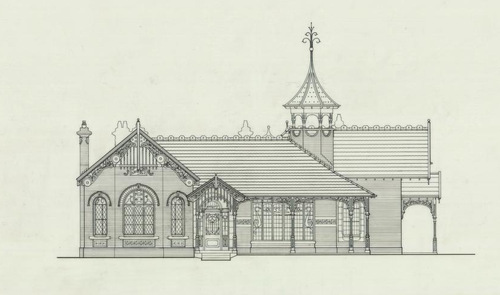 |
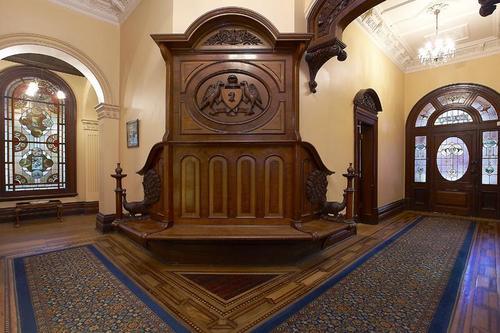 The hall stand and bench contain the Munro coat of arms. The hall stand and bench contain the Munro coat of arms. | 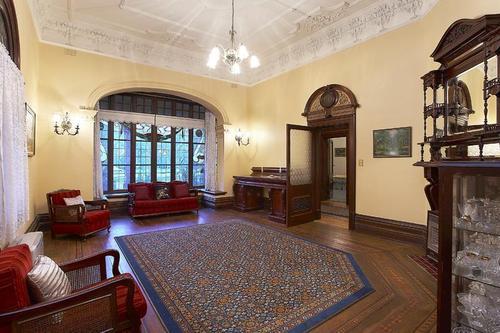 |
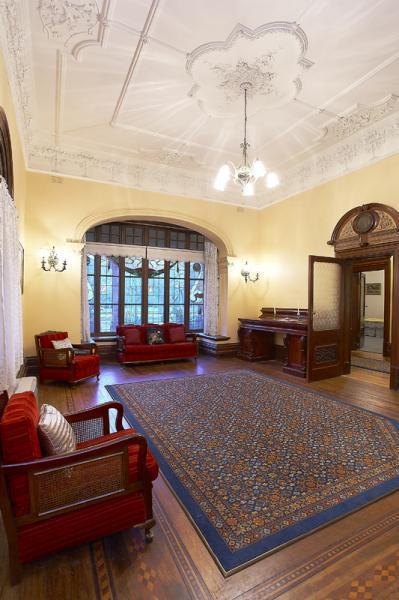 | 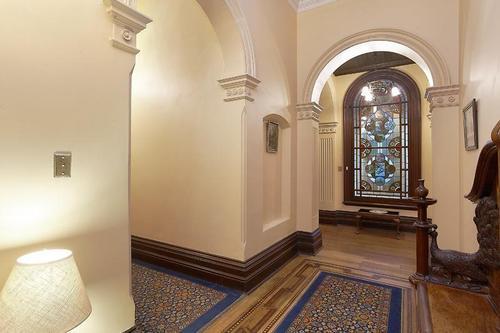  |
17 Park Drive, Parkville
Sold $1,180,000 in 22 Sep 2012 (Auction)A classic facade with a generous floor plan and comfortable for the family buyer.
- Retaining many period features throughout and spacious in size, this 2 level home offers leadlight entrance hallway, 4 bedrooms, separate study, lounge, kitchen and dining, central bathroom with spa, plus a fantastic terrace balcony with relaxing views overlooking Ievers Reserve and the bonus of rear access to off street parking.
- Located in one of finest streets in Parkville with superb mature trees running down its wide plantation, proudly nestled amongst many fine heritage homes.
 |  |
 |  |
- ^ http://www.onmydoorstep.com.au/heritage-listing/2829/parkville-post-office-and-quarters
- ^ http://www.travelvictoria.com.au/parkville/photos/
- ^ http://en.wikipedia.org/wiki/Parkville,_Victoria
- ^http://www.majorprojects.vic.gov.au/our-projects/our-current-projects/parkville-gardens#
- ^ http://en.wikipedia.org/wiki/Parkville,_Victoria
- ^ http://www.theweeklyreviewmelbournetimes.com.au/story/1801158/parkville-262-the-avenue/
- ^ http://www.domain.com.au/property/for-sale/house/vic/parkville/?adid=2011138767




















No comments:
Post a Comment